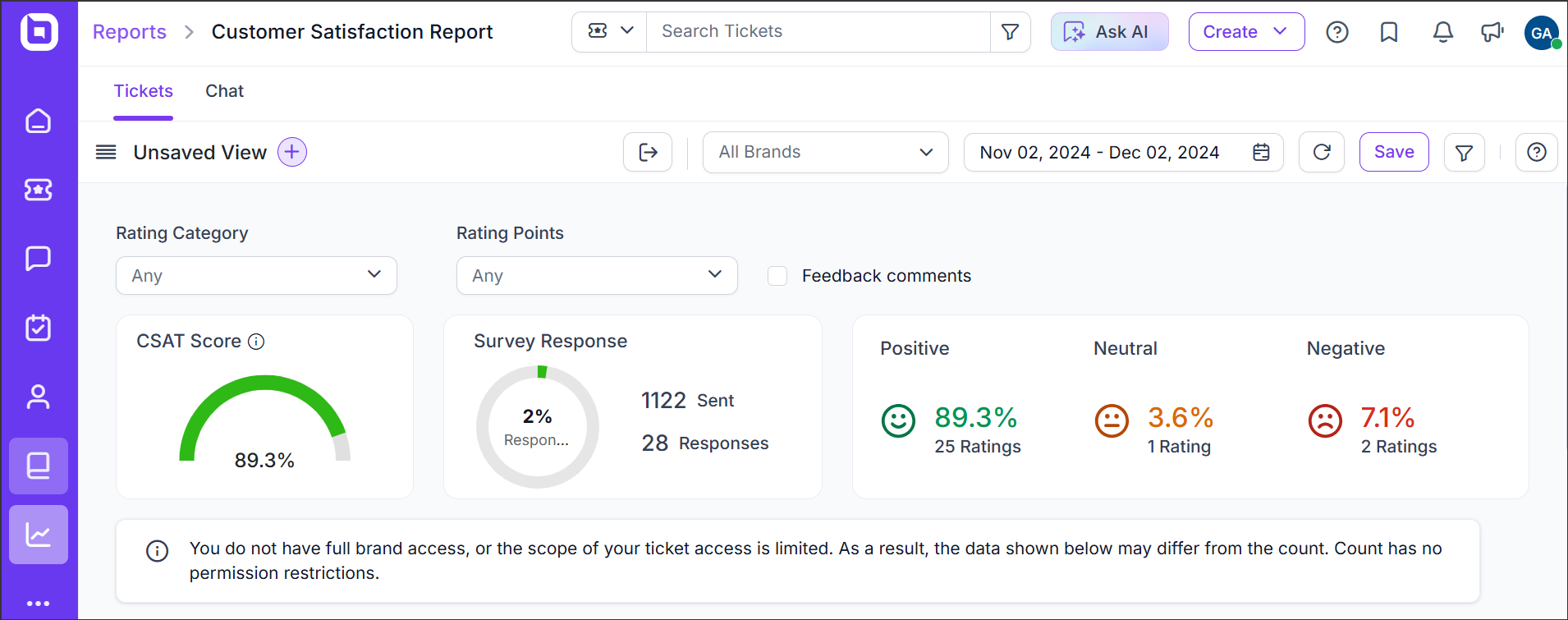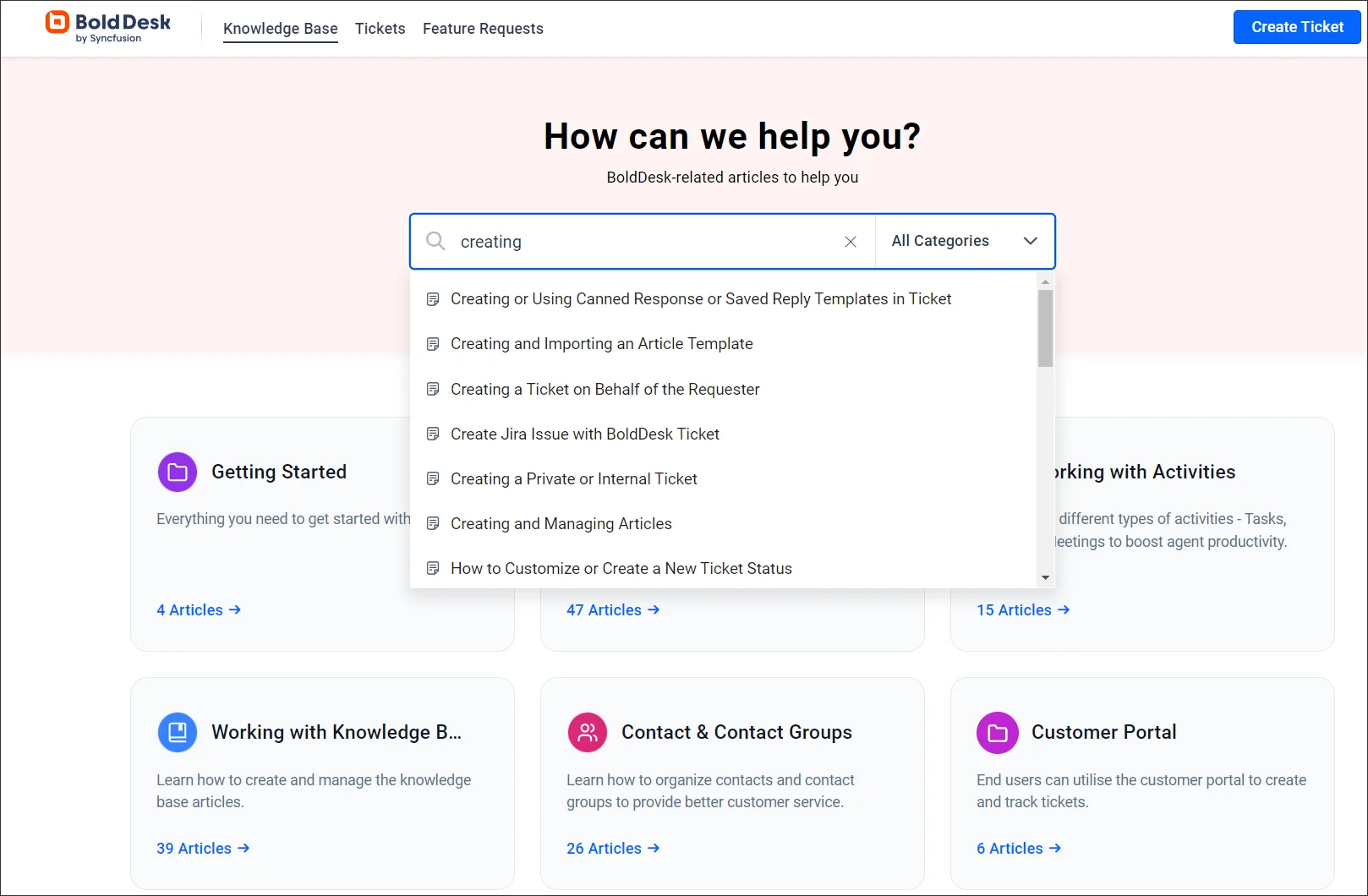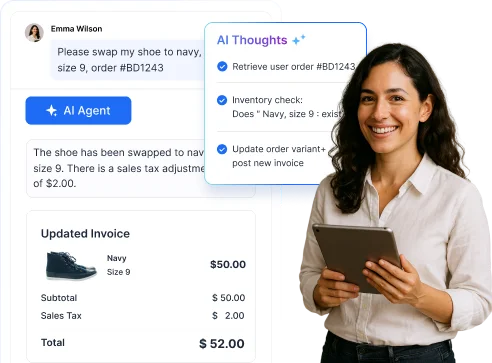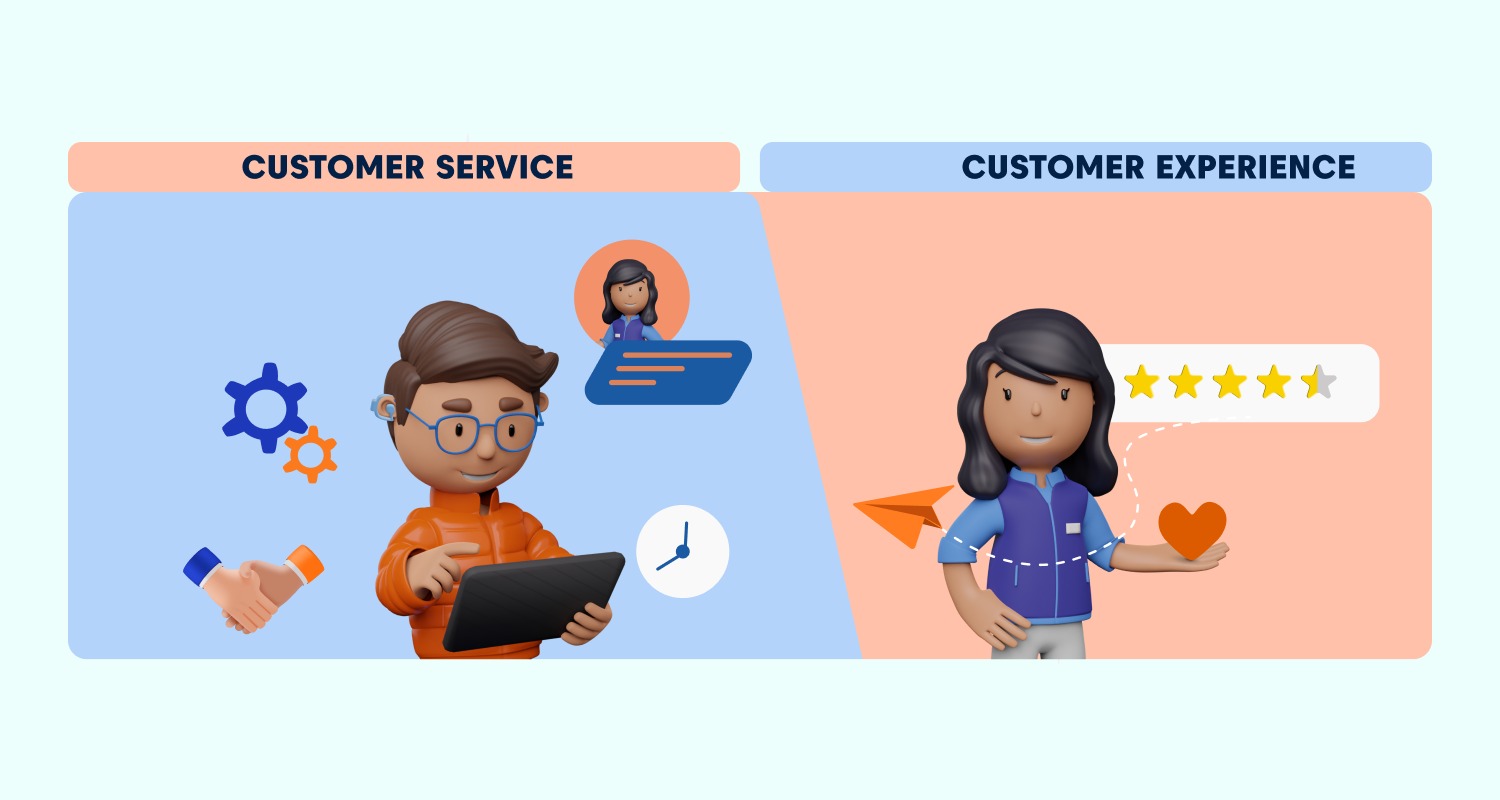Customer experience and customer service are two very common terms in business. However, many people confuse them and use them interchangeably. While they are certainly related concepts, they are not the same and represent different aspects of a client’s interaction with a business.
Research by Zippia says that 73% of customers believe customer experience is a vital aspect of purchasing. Similarly, statistics by 123FormBuilder prove that 81% of clients are likely to make another purchase after receiving outstanding customer service.
Seeing how vital they are, how can you differentiate between customer service vs customer experience?
In this blog, we’ll demystify the differences between these important business aspects.
Related articles
What is customer service
Customer service refers to any immediate support provided by a company to its customers before, during, and after they purchase a product or service.
Customer service encompasses the various ways a business engages with its customers with the aim of addressing customers’ needs and ensuring a positive overall experience.
What is customer experience (CX)?
Customer experience (CX) is a term that defines a customer’s overall perception, emotions, and impression towards a business or brand throughout their relationship.
CX is not confined to a single interaction or transaction; instead, it is an ongoing process that evolves.
The customer experience journey begins when a potential client becomes aware of a brand or business. This could be through advertisements, word-of-mouth, social media, or even an online search.
The journey continues as the customer engages with the brand, which could involve browsing your website, making inquiries, and ultimately purchasing.
But the customer experience doesn’t end at the point of sale.
Such negotiations after the sale consist of customer support service and client assistance, feedback requesting, and any communication that may occur between the business and the customer.
Every single instance of communication between a customer and the brand contributes to shaping the customer’s experience.
Brands need to ensure positive and memorable interactions, increasing customer advocacy, satisfaction, and loyalty.
Differences: customer service vs customer experience
Customer service and customer experience focus on different areas. Here are some of the notable differences of customer experience vs customer service.
Proactive and reactive approaches
When talking about approach, customer service tends to be in most cases reactive, where a problem arises or a customer asks a question, and then it starts to work.
Moreover, the primary aim is to fix it or answer the problem as quickly as possible.
In contrast, customer experience is more proactive in approach. Creating an experience strategy involves formulating and applying measures to ensure a positive customer experience at all interaction stages with the brand.
The goal of customer experience is to create a seamless and enjoyable customer journey.
Measuring success: key metrics
In terms of measuring success, there are different key metrics involved.
Customer service is typically gauged with help desk metrics such as first-call resolution, net promoter score (NPS), and customer satisfaction (CSAT) score.

These metrics are indicative of how efficiently customer queries or issues are resolved.
On the other hand, customer experience is quantified using metrics like customer effort score, retention rate, churn rate, and lifetime value estimate.
These metrics provide a measure of the overall satisfaction of the customer, their loyalty to the brand, and their likelihood to recommend it to others.
Touchpoints: limited vs all-encompassing
Customer service and customer experience also differ in the touchpoints they include. Customer service deals with specific touchpoints where customers seek help, such as phone support and email.
Conversely, customer experience encompasses all aspects of the customer journey, from sales to product usage and post-purchase interactions.
Objectives: problem solving and relationship building
Customer service aims to solve client issues as efficiently and as quickly as possible, with customer satisfaction in mind. It is about problem-solving and providing quick fixes.
In contrast, the goal of customer experience is to build long-term loyalty and advocacy. This can be done by consistently exceeding customer expectations, providing memorable interactions, and fostering strong relationships.
Summary of the differences between customer service and customer experience
| Customer service | Customer experience |
|
|
Similarities between customer service and customer experience
Customer service shares some similarity with customer experience. Below are a few of them.
The pivotal role of both
Customer service and customer experience both play a key role in any organization’s success. They revolve around meeting the needs and expectations of customers.
The primary purpose of both of these areas is to enhance customer satisfaction and cultivate positive relationships with customers.
They both strive to ensure that customer needs are met effectively and efficiently, which in turn helps to foster customer loyalty and retention.
The ultimate goal
Ultimately, a company’s goal is to establish and sustain strong customer relationships, which can be achieved through excellent customer service and a good overall customer experience.
Customer service is a major contributing factor to the customer experience, so improving your support system also improves your customers’ overall experience with your company.
Similar tools used
Both customer service and customer experience efforts frequently employ the use of customer relationship management (CRM) systems such as help desk software and knowledge base software.
These systems act as a central repository for customer data and history, ensuring consistency in customer interactions.
Same skill sets
Providing excellent customer service and customer experience both requires good customer communication skills, good knowledge of your audience, and empathetic responses to concerns.
Marketing, sales, PR, and support teams all contribute to the customer experience.
Knowing to whom they’re speaking, either directly or through an ad, and how to do so most effectively is what will make customers feel valued and understood.
Well-trained teams can use these skills to foster a positive relationship between clients and the brand.
Customer service particulars
Let’s explore more details on the best strategies and benefits of providing good customer service.
Strategies for delivering exceptional customer service
Customer service includes all the steps of providing customer support. To offer exceptional customer service, you must have strategies in place.
The following are some of the strategies for delivering exceptional customer service:
- Provide fast responses: Prioritize quick and effective responses to customer issues as a customer service strategy. Consider implementing automated customer service features to improve first response time in customer service. You can also prioritize a short first response time for all customers by quickly and efficiently replying to their product and service questions.
- Technical support: Offer efficient and expert assistance on technical issues. This includes technical issues such as bug fixing or working on complications related to virtual products or services. This is common in industries like technology and software. Any company with an online presence, though, will require technical support to keep their website running smoothly.
- Offer product usage assistance: Provide thorough guidance on product usage. This can be done by offering customers guidance on product use, including installation and setup.
- Continuous onboarding and training: Keep your customer service agents updated on product knowledge and service skills through continuous training. This ensures they can provide the best support and stay aligned with your brand’s values.
- Implement integrated multichannel support: Develop unified customer profiles that consolidate data from all interaction channels. This provides your agents with a complete view of the customer’s history and preferences, enhancing their ability to provide personalized service regardless of the communication channel used by the customer.
- Get customer feedback and implement suggestions: Regularly collect customer feedback and measure your customer satisfaction score to assess overall satisfaction. Use this data to make informed decisions and improvements for the next customer services. This strategy will also enhance your understanding of their needs, enabling you to provide more effective service.
- Do a post-sales follow-up: Providing ongoing support after a purchase helps you ensure that customers remain satisfied. This can also help you note concerns that your customers have, thus giving you a chance to address any additional needs that may present.
- Implement self-service: Empower your customers by offering self-service options. Develop a comprehensive self-service knowledge base software, enabling customers to find answers to common questions on their own.

Importance of exceptional customer service
Customer service is important to any business for multiple reasons.
- Increased customer lifetime value: Satisfied clients are more likely to stick around for longer, thereby increasing the total sales over time.
- Increased customer loyalty: Clients who feel valued and appreciated are more likely to remain loyal to a brand. As a result, they will do business with you even if there are cheaper options
- Shaping brand culture: Excellent customer service ensures a company’s commitment to customer satisfaction, thus making it world-famous.
- Gaining competitive advantage: Companies that prioritize customer service create a unique and positive brand identity, setting them apart from competitors and thus attracting more customers.
- Reduced churn rate: By providing excellent customer service at each touchpoint, businesses can make their customers feel valued and satisfied, reducing the likelihood of customer churn.
Customer experience particulars
Here are the detailed explanations on customer experience components, best practices, and its significance.
Components of a good customer experience
Brand quality: High-quality standards and consistent performance are the least customers expect from offered products. Customers expect the brand to fulfill its promises and remain true to its standards with time.
Customer interaction: Customers expect efficient, respectful, and personalized interaction from businesses. They want their issues and concerns to be addressed promptly and accurately.
Customer journey: Customers expect a seamless, enjoyable experience. They want easy navigation, transparent pricing, excellent customer service, efficient post-purchase delivery, easy returns/exchanges, and effective after-sales service.
Strategies for delivering an exceptional customer experience
The customer experience (CX) not only shapes the company’s reputation but also directly impacts its bottom line. To deliver an exceptional customer experience:
- Offer proactive engagement:Well, the conclusion of a transaction between a customer and a business is the most appropriate time to send a note of thanks for the customer’s patronage and the intention to offer any other assistance. Such proactive action indicates that the experience is appreciated beyond the transaction.
- Consider using automated help desk systems to ensure timely and consistent follow-ups.
- Customer relations: Focus on building and maintaining positive customer relations. You can build healthy bonds with your clients by using tailored marketing and providing high-quality products. It also helps to offer user-friendly website and store layouts, and supply quick and empathetic customer service.
Importance of the CX
The quality of customer experience can significantly influence a company’s success. Here’s why CX aspects matter:
- Boosting revenue: Customers are ready to pay more when the experience is great, making CX support pretty much a profit stream.
- Reducing customer churn: By providing a positive customer experience, companies can reduce customer churn. Dissatisfied clients are more likely to switch to competitors, so ensuring a high-quality customer experience can help retain customers and reduce customer churn.
- Reduced operational costs: Investing in CX service can reduce costs in the long run. It’s often more expensive to acquire new clients than to retain existing ones. By improving CX, companies can increase customer loyalty and reduce the need for costly acquisition strategies.
Customer service vs customer experience: Which is more important?
In conclusion, both customer service and customer experience play crucial roles in a company’s success. They shape the company’s reputation and directly impact its bottom line.
Integrate BoldDesk® into your cx support system to make an impact on your customer service and client experience offerings. BoldDesk is powerful help desk software that helps you understand your customers’ needs, expectations, and experiences.
BoldDesk offers a 30-minute live demo to give you a peek at what its features can do for your company and to let you ask any questions you may have. Or sign up for a 15-day free trial to explore on your own how its features can be customized and incorporated into your workflow. Let BoldDesk help you exceed your customers’ expectations.
If you have any questions, don’t hesitate to contact BoldDesk’s customer service.



















 Email Ticketing System
Email Ticketing System Shared Inbox Software
Shared Inbox Software Multi Brand Help Desk
Multi Brand Help Desk Internal Help Desk Software
Internal Help Desk Software Trouble Ticketing Software
Trouble Ticketing Software Mobile Help Desk
Mobile Help Desk 
















